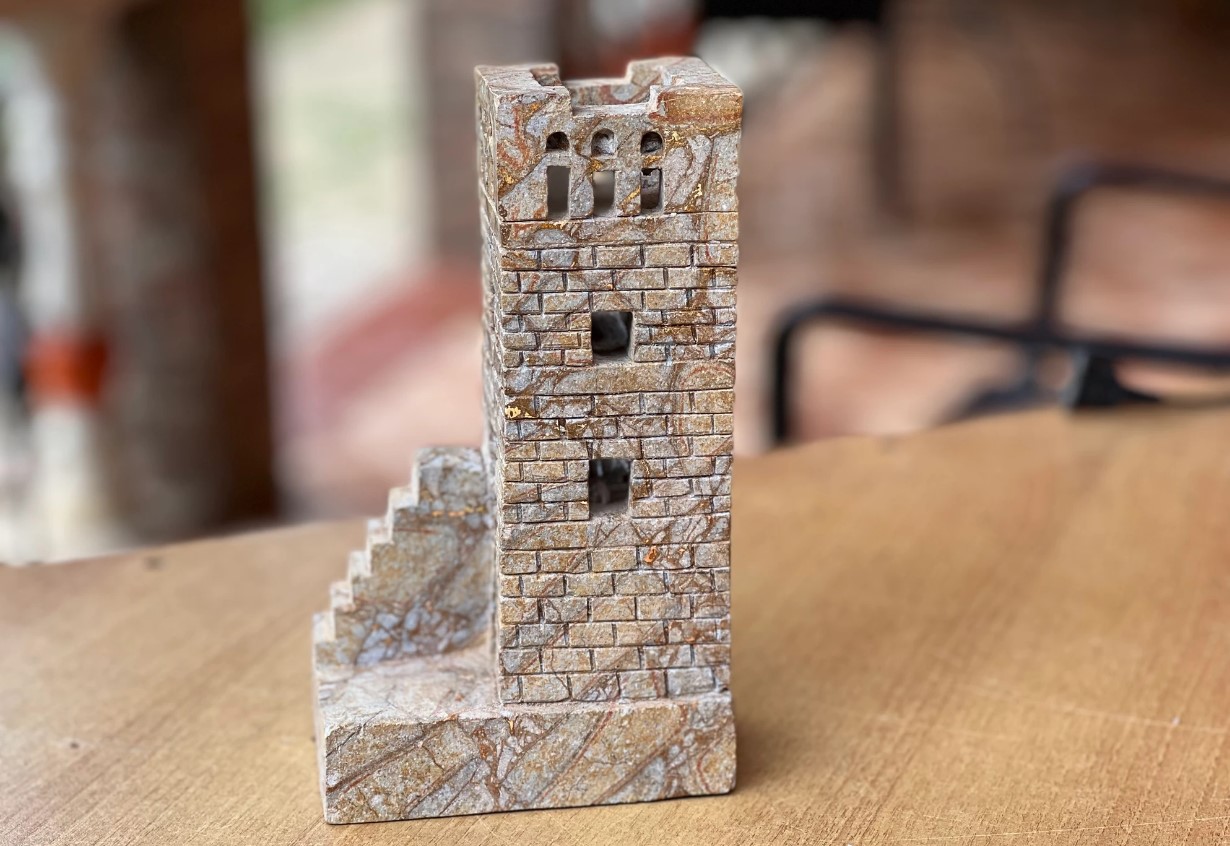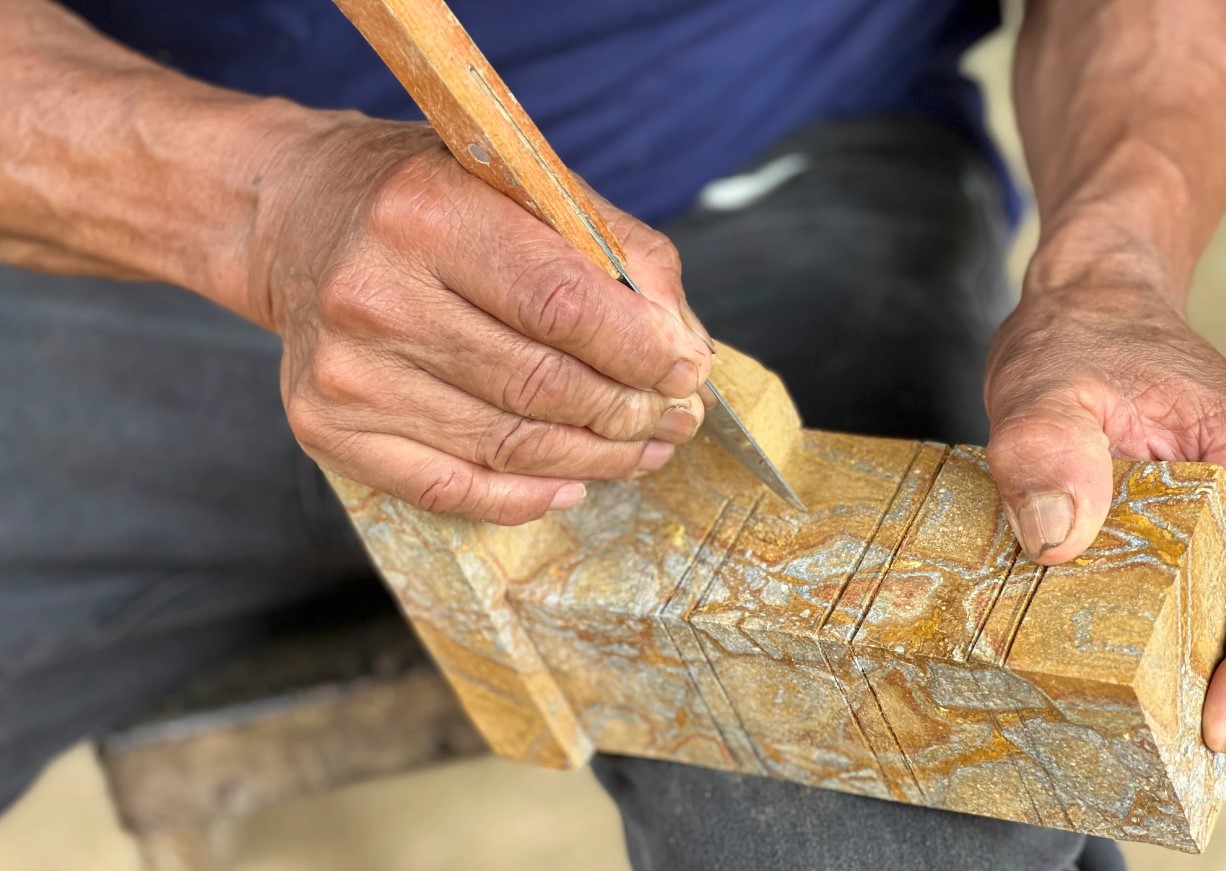Pasaporte Abierto 2023 honors the first colonial city founded on the American Pacific coast
Panamanian artisan José Soto is in charge of making the statuettes that the Pasaporte Abierto 2023 winners will receive.
Panama City.- The organizing committee of the seventh edition of the Pasaporte Abierto 2023 awards, whose gala will be held in Panama on September 4, will honor Panama City on its 504th anniversary celebrated on August 15 at the Monumental Complex of Panama la Vieja, the first colonial city founded on the American Pacific coast.
The statuette that will be given to each of the winners in the 13 categories is a representation of the Tower of Panama la Vieja, made with soapstone, a handicraft from the Coclé province.
The soapstone is part of a research project carried out by the Technological University of Panama and the City of Knowledge, since it is associated with the eruptions of agglomerates and volcanic breccias of the Anton Valley, one of the largest inhabited volcanic craters in the world.

The artisan in charge of making the statuettes is José Soto, the same one who made a Pope Francis bust with soapstone; the bust was delivered into the hands of the pontiff by Penonomé municipality mayor Paula González.
The first city of Panama was founded on the American Pacific Coast in 1519 and was attacked by pirates on several occasions, pirate Morgan among them, and its ruins still remain as a cultural tourist attraction visited annually by thousands of travelers.
Knowing Old Panama
Nestled on the shores of the Pacific Ocean, Old Panama stands as a testament to the early European exploration and colonization of the Americas. As the first colonial city on the American Pacific coast, it played a pivotal role in shaping the history and culture of the region. With a rich history that spans centuries, Old Panama remains a captivating archaeological site that offers a glimpse into the past.
Old Panama stands as a window into a pivotal era in world history. From its rise as a bustling trade center to its tragic fall at the hands of pirates, the city’s story is one of resilience, innovation, and the enduring legacy of colonial exploration. Today, the ruins of Old Panama offer a tangible connection to the past, reminding us of the intricate web of cultures, economies, and societies that once converged on the shores of the Pacific Ocean.

Founded in 1519 by Spanish explorer Pedro Arias de Ávila, Old Panama served as a vital hub for Spanish expeditions and trade routes between the Atlantic and Pacific Oceans. This strategic location allowed for the transfer of goods, ideas, and cultures between Europe and the Americas, cementing the city’s position as a crucial link in the global exchange network.
During its heyday, Old Panama thrived as a bustling center of commerce and trade. The city became a melting pot of cultures, attracting merchants, adventurers, and settlers from Europe, Africa, and various indigenous populations. This diverse influx of people contributed to the city’s vibrant economy, resulting in the construction of impressive infrastructure, including churches, plazas, and markets.
However, Old Panama’s success was accompanied by challenges. The city was vulnerable to attacks from pirates and rival European powers seeking to control its valuable trade routes. One of the most devastating events in the city’s history occurred in 1671 when the notorious English pirate Henry Morgan led an attack that left much of Old Panama in ruins. The city was burnt to the ground, marking the end of its status as a colonial powerhouse.
Despite the destruction, Old Panama’s ruins have managed to survive the ravages of time, and today they stand as a UNESCO World Heritage Site. The ruins showcase the remains of grand cathedrals, mansions, and fortifications, offering a glimpse into the architectural styles and urban planning of the colonial era.
The versatility of soapstone
Soapstone, a metamorphic rock known for its softness and distinctive feel, has captured the imagination of artisans and craftsmen for centuries. Its origins and remarkable qualities make it a favored medium for creating exquisite handicrafts that blend artistry with functionality.
Scientifically referred to as steatite, soapstone is primarily composed of talc, which gives it its characteristic softness and smooth texture. Found in various parts of the world, including North America, Africa, and Asia, soapstone has been historically quarried for its unique properties. The name “soapstone” stems from its texture, which is reminiscent of soap.
Soapstone’s versatility has made it a beloved choice for craftsmen in various cultures throughout history. Its ease of carving, rich colors, and tactile appeal have resulted in a wide range of practical and artistic creations. From functional items like bowls, pots, and even countertops to intricate sculptures and decorative ornaments, soapstone’s allure is undeniable.

One of the most remarkable features of soapstone is its malleability when freshly quarried. Artists and craftsmen can easily carve intricate designs and sculptures using simple hand tools. The smooth and pliable nature of the rock allows for the creation of detailed pieces that exhibit both aesthetic beauty and fine craftsmanship. The ability of soapstone to hold and radiate heat also makes it ideal for crafting items like cookware and fireplaces.
Different cultures have incorporated soapstone into their artistic traditions, each infusing their unique styles and stories into the medium. Inuit carvings from Canada and Greenland, for instance, often depict figures and animals from their natural surroundings. In Africa, soapstone is used to create functional items like bowls and containers, as well as symbolic sculptures that represent cultural beliefs and heritage.
Soapstone’s journey from the depths of quarries to the hands of skilled artisans results in an array of handicrafts that celebrate its innate beauty and malleability. Whether it’s a hand-carved animal figurine or a finely sculpted vase, soapstone continues to leave an indelible mark on the world of handicrafts, inviting us to appreciate its timeless charm and the craftsmanship it inspires.
__________________
By Adrian Morales
Senior Staff Writer
adrian.editor@gmail.com